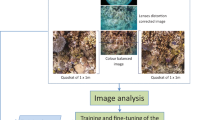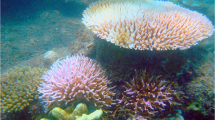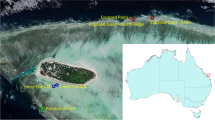Abstract
Almost three-quarters of the world's coral reefs are thought to be deteriorating as a consequence of environmental stress. Until now, it has been possible to evaluate reef health only by field survey, which is labour-intensive and time-consuming. Here we map live coral cover from the air by remote imaging, a technique that will enable the state of shallow reefs to be monitored swiftly and over large areas.
Similar content being viewed by others
Main
It is predicted that coral reefs will suffer mounting stress associated with a global increase in atmospheric carbon dioxide over the coming decades1,2 and from local disturbances such as overfishing3 and disease4. The most obvious effect of such stress is a decline in living coral cover, so a temporal change in cover is a good indicator of the state of health of a coral reef. However, the measurement of coral cover by field survey5 is impractical on the scale of hundreds to thousands of square kilometres.
Measurements of the reflected light spectra of reef biota and substrata indicate that the dominant groups can be distinguished in situ6,7,8,9,10, but until now it has not been clear whether such spectral differences can be detected remotely from the air or from space. We acquired high-spatial-resolution (1 m × 1 m), multispectral images from the air of two reefs in the lagoon of Rangiroa Atoll, French Polynesia, by using a compact spectrographic imager. We carried out this imaging in November 1998 because coral populations had suffered significant mortality after the extreme El Niño/Southern Oscillation that occurred in the austral summer of 1997–98 (ref. 11). At the same time, we carried out detailed in situ surveys of coral populations on each reef.
The first reef was dominated by large live and dead colonies of Porites, the remotely sensed spectra of which were readily distinguishable on the basis of their first spectral derivatives (rate of change of reflectance versus wavelength12) in the wavelength region 506–565 nm, as expected from in situ measurements8.
The habitat of the second reef was highly heterogeneous and we used the imager to estimate the percentage cover of all sub-strata in ten plots of 25 m2 each. Although within-plot estimates of the cover of dead Pocillopora coral, coralline red algae and sand varied by as much as 25–29%, estimates of live coral never differed from field data by more than 10% (Table 1). At a whole-reef (interplot) scale, estimates of the mean cover of all major benthic categories differed by less than 8%, and the cover of both live and dead coral was estimated to within 3%. There were no significant differences in estimates of mean habitat cover at the 95% confidence level (paired t-tests).
The video surveying methods currently used by scientific divers on the Great Barrier Reef are estimated to have a 95% probability of detecting a 10% change in live coral cover from one year to the next13. Power analysis of our data indicates that 22 plots of 25 m2 each would need to be surveyed by remote sensing, compared with 20 equivalent-sized plots by video camera, to achieve the same level of statistical resolution on the reefs surveyed (that is, similar sample sizes for field and remote methods). However, spectographic images can be acquired over areas that are many times larger than those that can be surveyed underwater.
We anticipate that the application of multispectral remote sensing will significantly improve estimates of coral cover and changes in coral cover over time. It took us 1 hour to acquire images over 92,500 m2 of reef, which represents 3,700 plots of 25 m2 each, compared with 3 days to survey 10 such plots underwater. Moreover, remote images are acquired as numerical data, which can be rapidly processed electronically, reducing the time needed to generate estimates of surface cover.
References
Pittock, A. B. Am. Zool. 39, 10–29 (1999).
Kleypas, J. A. et al. Science 284, 118–120 (1999).
Hughes, T. P. Science 265, 1547–1551 (1994).
Harvell, C. D. et al. Science 285, 1505–1510 (1999).
English, S., Wilkinson, C. & Baker, V. Survey Manual for Tropical Marine Resources (Australian Inst. Mar. Sci., Townsville, 1997).
Holden, H. & LeDrew, E. Remote Sensing Environ. 65, 217–224 (1998).
Myers, M. R., Hardy, J. T., Mazel, C. H. & Dustan, P. Coral Reefs 18, 179–186 (1999).
Clark, C. D., Mumby, P. J., Chisholm, J. R. M., Jaubert, J. & Andrefouet, S. Int. J. Remote Sensing 21, 2321–2327 (2000).
Hochberg, E. J. & Atkinson, M. J. Coral Reefs 19, 164–171 (2000).
Lubin, D., Li, W., Dustan, P., Mazel, C. H. & Stamnes, K. Remote Sensing Environ. 75, 127–137 (2001).
Mumby, P. J. et al. Mar. Biol. 139, 183–189 (2001).
Tsai, F. & Philpot, W. Remote Sensing Environ. 66, 41–51 (1998).
Carleton, J. H. & Done, T. J. Coral Reefs 14, 35–46 (1995).
Author information
Authors and Affiliations
Corresponding author
Rights and permissions
About this article
Cite this article
Mumby, P., Chisholm, J., Clark, C. et al. A bird's-eye view of the health of coral reefs. Nature 413, 36 (2001). https://doi.org/10.1038/35092617
Issue Date:
DOI: https://doi.org/10.1038/35092617
This article is cited by
-
Habitat maps to enhance monitoring and management of the Great Barrier Reef
Coral Reefs (2020)
-
Susceptibility to Aspergillus Infections in Rats with Chronic Obstructive Pulmonary Disease via Deficiency Function of Alveolar Macrophages and Impaired Activation of TLR2
Inflammation (2016)
-
What spatial scales are believable for climate model projections of sea surface temperature?
Climate Dynamics (2014)
-
Predicting spatially explicit coral reef fish abundance, richness and Shannon–Weaver index from habitat characteristics
Biodiversity and Conservation (2012)
-
Predictability of reef fish diversity and abundance using remote sensing data in Diego Garcia (Chagos Archipelago)
Coral Reefs (2008)
Comments
By submitting a comment you agree to abide by our Terms and Community Guidelines. If you find something abusive or that does not comply with our terms or guidelines please flag it as inappropriate.



